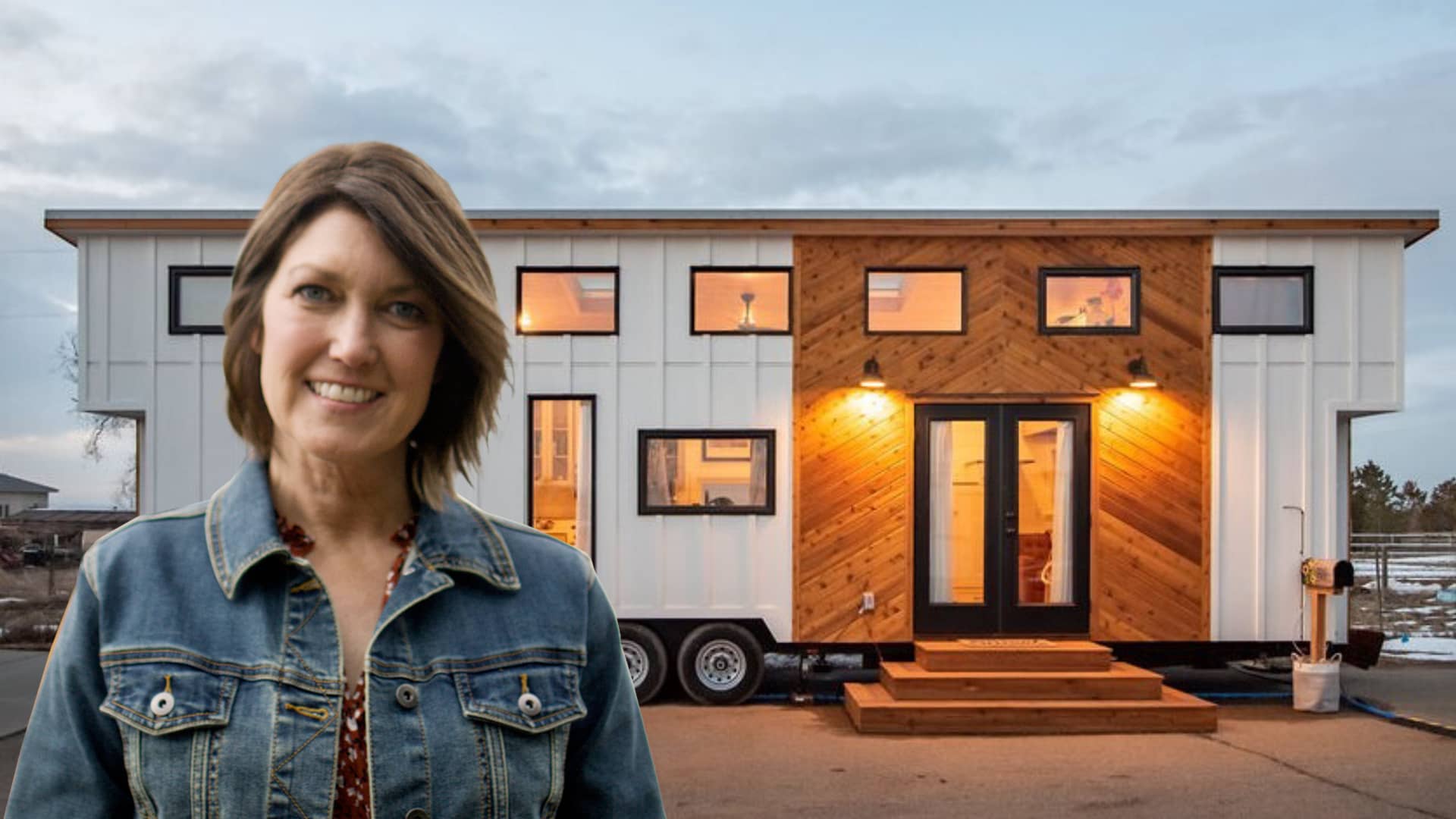Starter homes have become a 'fairy tale,' so Americans are finding other ways to own: 'My house has a license plate'
With home prices surging 33% in the last three years, homebuyers are finding novel ways to keep mortgage costs low.

In 2020, Amanda Schneider was forced out of her rental unit near Nashville, Tennessee, when her landlord sold the property.
Tired of renting, she decided she wanted to own and pitched an unusual idea: co-buying a home with her two roommates.
The more they thought about it, the more it made sense. The three women, all in their 20s, were close — "like siblings" — and splitting the costs afforded them a home they couldn't have purchased on their own.
Schneider and her roommates aren't alone in finding creative ways to finance their first home amid surging prices. Co-buying with friends is an increasingly popular idea, as the number of co-buyers with different last names has increased by 31% since 2019, according to most recent data from ATTOM, a property data provider.
This, and other unusual housing situations, are largely out of necessity: U.S. median home prices have surged 33% since January 2020, from $329,000 to $436,800. To afford the monthly mortgage payment on a median-priced home, homebuyers need to earn more than $100,000, well above the U.S. median household income of $70,784, according to Census Bureau data.
And the "starter home" — typically, a modestly priced two-bedroom home with fewer amenities, such as less storage space or no backyard — has become exceedingly rare, except in a handful of markets.
The idea of a 'starter home' has become more of a fairy tale.
Denis Smykalov
real estate broker at Wolsen Real Estate
"The idea of a 'starter home' has become more of a fairy tale," says Denis Smykalov, a Florida-based real estate broker at Wolsen Real Estate.
As a result, "it's become increasingly challenging for first-time buyers to find an affordable entry-level property that meets their needs," says Smykalov. "Now, many first-time buyers are forced to save for a longer time, or consider alternative options."
Here's a look at how a handful of people are navigating a tough housing market, from buying tiny homes to renting out part of their property to sharing the costs with friends.
Buying a home with friends: 'It broadens the possibility of what we could get'
It didn't take long for Schneider and her roommates, Stephanie Vandergrift and Kathy Keel, to decide to split the cost of buying a house. They knew they still wanted to live together and all share the same mindset, Schneider says.
"The three of us are very career-focused and we're not interested in marriage or having children."
Left to right: Amanda Schneider, Kathy Keel and Stephanie Vandergrift.
Courtesy of Amanda Schneider.
By owning a home together, they could commit to something "more long-term where it's also an investment," says Schneider. Plus, they'd have more control over renovations and repairs, the costs of which would be easier to cover with three people paying.
After a few weeks of searching, the roommates found a two-story detached brick home on 1.25 acres of land in Gallatin, Tennessee, for $315,000. The home features three bedrooms, a finished garage with a room above it, a downstairs office and a large yard with a fire pit.
They made a down payment of 10% and took out a mortgage for the remaining costs, which they split evenly. Other expenses, including utilities and repairs, are split evenly as well. If one of them decides to move out, the other two roommates have a plan to buy out their share of ownership.
"As a single purchaser, I don't think I couldn't have gotten something as nice," says Schneider. "With three incomes, it broadens the possibility of what we could get, and we genuinely enjoy living together as a unit of roommates."
Amanda Schneider, Stephanie Vandergrift and Kathy Keel's home.
Courtesy of Amanda Schneider
It's been a smart financial move too. As an investment, the home has "skyrocketed" in value since Schneider and her roommates moved in three years ago, she says.
However, buying a home with friends isn't for everyone. It's "essential" that you're on the same page with your co-buyers, Schneider says, so that "you work together as a unit, rather than just three separate people living in the same home."
While they qualified for a larger mortgage, they set a spending cap of around $325,000. They wanted to keep monthly mortgage payments low to ensure that two roommates could cover the costs if one of them decided to move out.
Amanda Schneider, Stephanie Vandergrift and Kathy Keel outside their new home in 2020.
Courtesy of Amanda Schneider.
"We're very grateful," says Schneider. "It feels like a home, rather than a temporary situation. We now have such a strong asset that assures us we made the right choice in purchasing a home together."
Renting part of your home while living in it: 'You get two units you can rent out for a lot more'
In 2019, 25-year-old Vadim Yuryev and his wife, Annette, had enough money to purchase a starter home for their young family in Spokane, Washington, where he was raised. But he also wanted a cash-generating property that could help cover the monthly costs.
The solution: house hacking, which is when homeowners partially or entirely cover their mortgage by renting out part of the property, whether that's a room or a detached unit, like a pool house or backyard cabin.
Vadim and Annette Yuryev.
Courtesy of Vadim Yuryev.
"I went with a duplex because there is more value in it," says Yuryev, now 29. "It isn't that much more expensive than a house, but you get two units you can rent out for a lot more than the mortgage."
Yuryev bought the duplex for $235,000, which was financed with a 15% down payment and a $200,000 mortgage. He and his wife spent another $35,000 on renovations for one half of the property, which is where the couple lived while renting out the other half.
In 2021, Yuryev took advantage of low interest rates and refinanced the mortgage, lowering the rate from 3.99% to 2.875%. This brought monthly mortgage payments — which included property taxes and insurance — down from $1,329 to $1,217.
Most of that was offset by the $1,000 they received in monthly rental income. All told, Yuryev only paid around $500 in monthly housing costs to cover the rest of the mortgage plus utilities.
The couple moved out of the duplex to a bigger rental unit in January 2023. The duplex is a cash-generating property now, with both units currently rented out for total monthly revenue of $2,800.
Vadim and Annette Yuryev outside their duplex.
Courtesy of Vadim Yuryev.
Despite the income, there were downsides to renting out part of the property, Yuryev found. While renters can help bring down costs, you still need a lot of cash upfront, especially for older buildings, he says. To cover the costs of repairs and potential vacancies in his rental unit, Yuryev maintained a cash reserve of $15,000 while he was an owner-occupant.
Eventually, the Yuryevs plan to buy another home, but they're waiting out the real estate market for now due to high interest rates and the expectation that home prices in Spokane will cool off at some point.
Buying a tiny home: 'It didn't seem like a compromise at all'
When her 18-year marriage ended in 2018, Jen Gressett found herself priced out of the real estate market in Boulder, Colorado.
She had been living in a four-bedroom, 3,000-square-foot house with her then-husband and their two kids, but as a single income earner in a housing market where median home prices were over $600,000, buying a regular-sized home on her own wasn't an option.
One way around the sky-high prices: simply own less home.
A tiny home — often portable and less than 400 square feet — costs an average of $52,000, which is 87% cheaper than a regular home, according to a 2022 Porch.com survey.
Jen Gressett in front of her tiny house.
Photo courtesy of Jen Gressett
"I looked into apartments, since that's what most people do when they get divorced," she says. "But it was so expensive — a two-bedroom was almost $2,000 a month."
Gressett was aware of tiny houses, but it wasn't until she saw some of the nicer ones that it made more sense as a place to live. "I could see myself living in one. And it didn't seem like a compromise at all," she says.
In 2021, Gressett, moved into a custom-made tiny house that runs her $725 per month. "Because I'm on a single income, paying only $725 per month gives me peace of mind," says Gressett. "It allows me to save more and be better prepared should any unexpected financial needs arise."
The tiny home has a quartz countertop kitchen, soaker tub and a king-sized bed. Her house is portable, too. "It's basically a vehicle — my house has a license plate."
Overall, Gressett spent $175,000 to build her tiny home, including a prefabricated shell structure, labor and material costs. She paid for it using $85,000 from the sale of her previous home, as well as a personal loan of $90,000 from a close friend.
That said, she says she made a lot of mistakes along the way. The biggest one: Hiring her first builder, who wasn't properly certified and took too long to build the home. "He had the wrong roofing, and one of the windows completely fell out," she says. "So many things had to redone, and I had to pay for them to be redone."
Inside Jen Gressett's tiny home
Photo courtesy of Jen Gressett
But it's been a smart decision overall. "For me, the best part of tiny house living is it takes way less time to clean than a regular home," says Gressett. "I can get everything clean in about an hour, which gives me more time to be out doing things I love, like trail running or hiking."
Gressett has fully embraced the tiny home lifestyle, sharing advice and tips to over 160,000 followers on her Instagram account.
"Thinking long-term, living in a tiny house long-term kind of works," she says. "If my kids decide to leave Colorado or whatever, I could just move my house to follow them to wherever they end up."
DON'T MISS: Want to be smarter and more successful with your money, work & life? Sign up for our new newsletter!
Get CNBC's free Warren Buffett Guide to Investing, which distills the billionaire's No. 1 best piece of advice for regular investors, do's and don'ts, and three key investing principles into a clear and simple guidebook.


 ValVades
ValVades 































